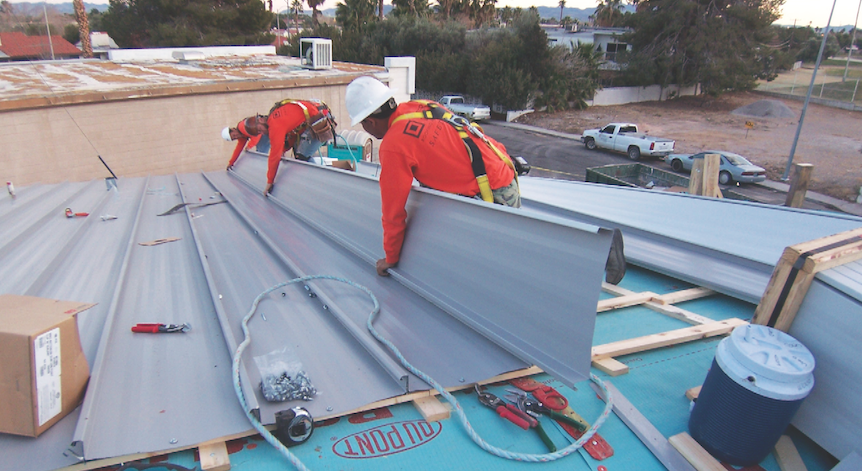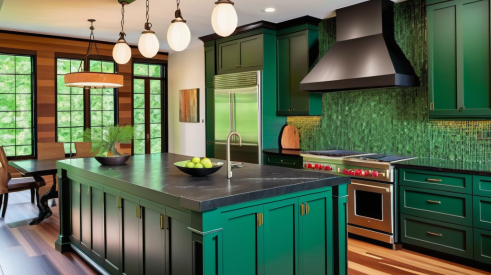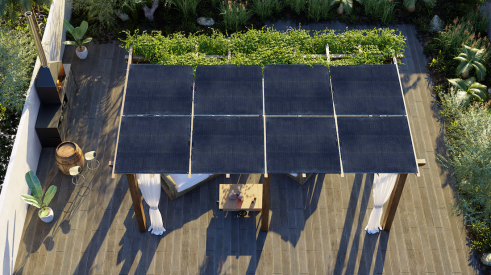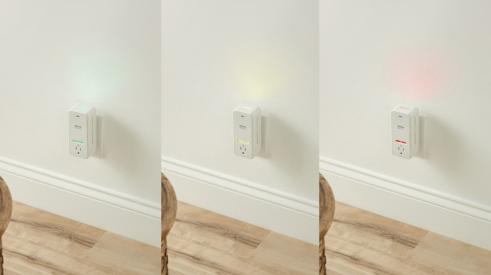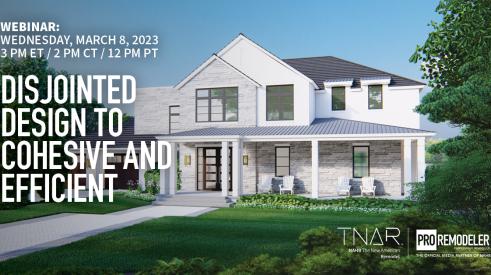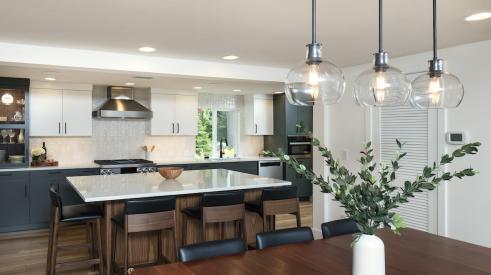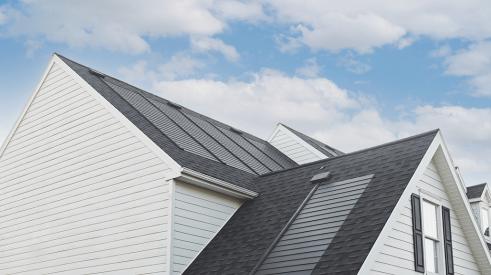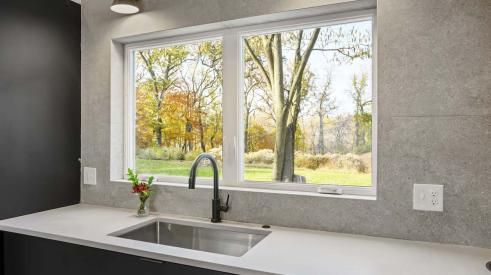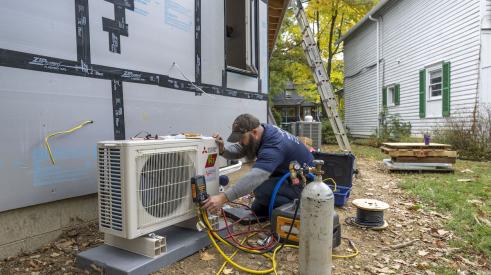All photos: courtesy Building Media
To upgrade or not to upgrade, that is the question—or at least it is when it comes to energy-efficient retrofits to a home remodeling project. While it may be nobler to include energy enhancements, does it make financial sense? Or does a remodeler (with apologies to Shakespeare) face the slings and arrows of outrageous economics?
A recent report from the University of Chicago and the University of California, Berkeley, raised red flags across the industry. Titled “Do Energy Efficiency Investments Deliver? Evidence from the Weatherization Assistance Program,” the study purported to assess return on investment from federally funded weatherization programs in 30,000 low-income Michigan households. Based on the findings, the researchers concluded “… that the upfront investment costs are about twice the actual energy savings,” adding that, “Overall, the energy efficiency investments we evaluated are poor performers ... across a variety of metrics.”
Since its release in late June 2015, the Michigan study has received thoughtful rebuttal on its methodology and metrics, including questions surrounding the types of upgrades made, the limitations of a weatherization program versus a deep energy retrofit, and the possibility that just 616 homes, not 30,000, were actively studied. Regardless of how these and other challenges are resolved, however, the Michigan study raises deeper questions for the remodeling industry about how the costs and benefits of energy performance are defined and measured, and how important economic analysis should be in the decision to remodel.
Shallow vs. Deep Upgrades
To begin to answer these questions, we need to look at both the type of energy upgrades made and the methods of evaluating their cost. “Shallow” upgrades involve simple measures, such as replacing inefficient lighting, while “deep” retrofits often involve upgrades to the home’s envelope and HVAC systems. Economic measures include everything from simple payback, which measures energy savings over time against total cost for the upgrades, to more complex models that use incremental costs, energy price fluctuation, and other factors. A couple of examples will illustrate how these models differ.
Simple payback. Typically, energy savings goals are calculated as a reduction from current energy use, as determined through utility bills. For example, a 2013 “shallow” retrofit of 56 all-electric existing Florida homes included replacing a little over half of the incandescent lighting with new CFLs or LEDs, and placing advanced power strips (APS), which cut standby power loss, on the homes’ entertainment centers.
A short-term analysis showed a seasonally adjusted 17 percent reduction to total site power compared with the pre-retrofit condition. For the lighting retrofits, based on average installation costs of $67 for labor and $214 for materials, simple payback (total investment ÷ annual savings) is projected to be five years; for the $32 smart strips, simple payback ranges from one to three years.
Return on investment. An arguably more realistic economic measure is return on investment, whereby different energy-efficient upgrades are appraised against one another, as well as against a “business-as-usual” investment. A simple example would be to compare a standard-model water heater replacement with one using a more energy-efficient model.
Let’s return to Florida and a two-year study of 60 homes. All homes were heavily metered and received “shallow” retrofits (LED/CFL lighting, hot water tank insulation, restricted pool pump operation, smart strips, etc.). In addition, 10 homes received a “deep” retrofit that included replacement of major appliances and HVAC equipment and controls, and other improvements. While total cost for the deep retrofits averaged $14,500, the incremental cost—the difference in cost for more efficient measures compared with standard measures—averaged about $7,200. Based on average savings of about $80 per month, the study reports a return on the total cost of around 6 percent, or a 16-year payback. However, based on incremental cost, the deep retrofits pay back in a little less than eight years.

Baseline Conditions Matter
In the above example, there was a big economic advantage simply because energy retrofits coincided with major equipment and appliance replacements. There is also evidence that how much efficiency bang you get for your energy retrofit buck depends on the condition of the existing property. In a broad study that examined reported retrofits across the U.S., Brennan Less and Iain Walker concluded that air sealing is essential, cost-effective, and “smart in nearly all deep energy retrofit projects,” but many of the projects that had a positive ROI started out uninsulated and drafty, and used an expensive heating fuel such as diesel, so upgrades resulted in larger-than-average energy bill reductions.
The Building America Research Alliance (BARA) draws a similar conclusion based on a study of New Jersey homes retrofitted under Home Performance with Energy Star (HPwES), which uses a “house as a system” approach focused on improvements to the building envelope and mechanical systems. The BARA report agrees that addressing a home’s envelope is most effective in homes without prior air sealing work and in homes with low levels of insulation in the walls, attic, and at the rim joist and basement.
Generally, then, the evidence suggests what common sense dictates: that the worse shape a home is in before energy upgrades are made, the greater the energy savings and shorter the payback period. Moreover, reducing overall energy use as much as possible is a prerequisite to adding renewable energy measures, and combining all categories of improvements with upgrades to the home’s envelope yields significantly greater savings than any one improvement alone.

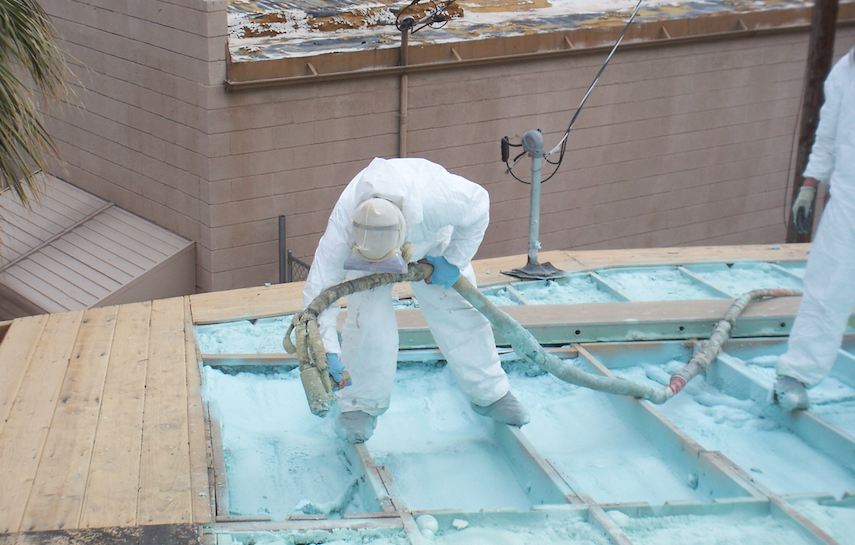
What About Energy Prices?
So in simple mathematical terms, some retrofits can, in fact, pass the payback test. But is payback a fair question to begin with?
“I think one of the problems is that people look at this as a simple payback equation,” says Doug Selby, president of Meadowlark Builders, in Ann Arbor, Mich. “But we all know that energy prices rise, and at a rate that’s higher than inflation. So in my opinion, that has to become part of the equation.” Selby says it’s not uncommon for his company to save a client $100 per month in total energy bills through an insulation retrofit that may cost $12,000. So what’s the payback?
“If energy costs stay the same, simple payback is 10 years,” Selby says. “In reality, though, it works out to more like nine years with a rise in the cost of energy,” based on a historical average increase of about 5 percent. “If you invest the money that you would have paid anyway, before the retrofit, in a vehicle that earns 6 percent, payback is a bit more than seven years.”
For Selby, though, the real savings accrue over a longer period. “What’s remarkable is the savings over 25 years,” he says. “When compounding interest starts hitting this, [simple payback] turns into a savings of more than $50,000. Invested at a 6 percent rate of return, it’s more than $100,000 in a homeowner’s pocket.” (See “Simple vs. Compounded Savings,” below.)
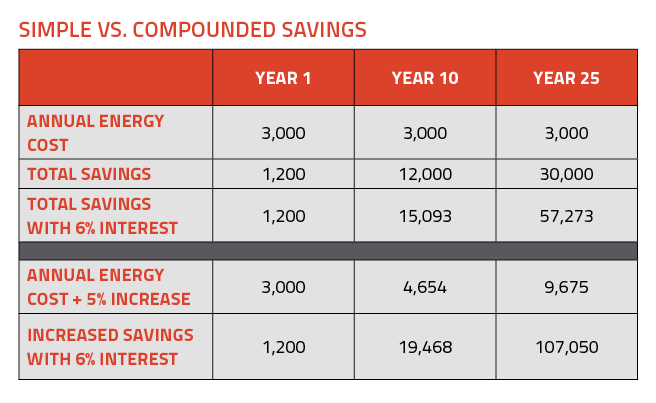
The top half of this table shows simple savings based on a $100 per month reduction in constant total annual energy costs of $3,000, as well as how savings accrue when invested at 6 percent interest. The bottom half uses the same reduction, savings, and investment assumptions, but is based on a 5 percent annual increase in energy costs.
Selby points out that the same financial mechanisms are in play when replacing any appliance with a high-efficiency model. “If you have to replace a hot water heater, an efficient model might cost $2,000 more than an entry-level model,” Selby explains. “But you’ll save about $20 per month on your gas bills. So [at current prices] in just over eight years, you’ve paid for the upgrade. It’ll probably last longer, too. Over the life of the equipment, you may save four to six times the amount of the upgrade cost depending on how many more years you get out of better equipment.”
True Cost of Energy
While it’s obvious that the cheapest energy is the energy you don’t use, there are those who believe that the price of energy doesn’t reflect its true cost. Currently, efficiency costs 2¢ to 3¢ per kWh, while building new power plants costs 9¢ to 18¢ per kWh, depending on the type of power. But that doesn’t account for costs that we so often fail to include.
“Energy consumption should be measured in terms of environmental damage, such as carbon emissions, resource depletion, or habitat destruction,” points out John Straube, Ph.D., P.Eng., principal at Building Science Laboratories. “None of these impacts are easily measured.” For Straube, reducing operational energy use and increasing durability should be the prime concerns of those who design, build, and remodel “green” buildings.
More to Remodeling Than Economics
There are other factors in play beyond finances when homeowners make the decision to undertake a remodeling project. Research shows that other motivators overcome homeowners’ concerns about initial financial outlay and spur them to invest in energy retrofits (see “Motivating Factors for Deep Energy Retrofits,” below).
 Research has shown that nonfinancial benefits trump cost concerns as the primary motivators in homeowners’ decisions to invest in expensive energy upgrades.
Research has shown that nonfinancial benefits trump cost concerns as the primary motivators in homeowners’ decisions to invest in expensive energy upgrades.
“To quote [longtime building performance contractor] Rick Chitwood: The best return on investment in a heating climate is a $200 down jacket,” says Bill Robinson, founder of Train2Build, which provides jobsite training for contractors. “We’re not selling energy efficiency, we’re selling comfort. If low heating bills really mattered, people would simply turn down their thermostats.”
Paul Eldrenkamp, president of Byggmeister Associates, a Massachusetts remodeling company with a strong focus on deep energy retrofits, admits that a lot of energy improvement work can’t be justified by financial payback alone. “But we don’t hold remodeling work to that standard anywhere else, so why are we shifting to a pure economics model when it comes to energy?” Eldrenkamp asks. “And why voluntarily?”
For Eldrenkamp, the recipe for successful energy retrofits is to get the client thinking about the long term. “What we do as remodeling contractors is home stewardship,” he says. “Think about the master plan of the house, what it looks like in 40 or 50 years. Is it part of the solution or part of the problem? What’s best for the home over time?”
There are other benefits and motivations as well. “A lot of people are making remodeling decisions because they want to flat out do the right thing, despite the economics,” says Devon Hartman, founder of Community Home Energy Retrofit Project. “There is a litany of benefits from an energy retrofit, beyond global reductions, comfort, or IAQ. How do you measure the value of having a grandparent be able to live with you in the winter, or feeling better about your baby crawling around on the floor?”
Taking a holistic view—one that values both the client’s priorities and what’s best for the home—a remodeler can plot what steps fit best, given the client’s budget. Are there incremental cost opportunities if a homeowner is facing an equipment replacement regardless? Will the retrofit measures taken help secure the home’s performance in 40 years?
“We end up working with clients based on their current needs, but these decisions can be ad hoc choices in the long view,” Eldrenkamp emphasizes. “Instead, we need a master plan. The question becomes, ‘How do we expand the desirability of health, comfort, and energy improvement components to that routine homeowner?’ I think the performance of a home is a quality issue every bit as much as the gleam of countertops or the tightness of miter joints.”
Do Energy Retrofits Pay?
“Think of investing in performance retrofits as winning the future in the face of unpredictability,” Hartman says. Increasingly, retrofit strategies are evaluated for their positive effect on durability and indoor air quality in addition to energy performance. And while finances are certainly important, economics is nowhere near the top of the list for homeowners.
“I see ‘healthy homes’ as a key new market driver,” says Peter Troast, CEO of Energy Circle, which helps energy-efficiency companies with marketing. “It ties so well to remodeling because so often an unhealthy home comes from a wet basement or leaky envelope. So, in addition to dealing with the core sources of lack of health, there’s also an opportunity for a basement renovation.”
“The question is not whether a market is there, but how to understand the value and articulate it,” Hartman says. “How good a builder do you want to be, anyway? You can’t be the best builder and not know about this or know how to build with this is mind.” Ultimately, by upgrading a home’s energy performance, a remodeler can (with further apologies to Shakespeare), “take up arms against a sea of troubles, and by opposing end them.”
What’s It Worth? Appraising High-Performance Homes
To translate a home’s energy assets into dollars and cents, an appraiser needs a thorough understanding of what a particular home brings to the market. One newer tool is the Appraisal Institute’s Residential Green and Energy Efficiency Addendum (Form 820.04), which lists upgrades to the home, including insulation, air sealing, water efficiency, windows, daylighting, appliances, and HVAC systems. The form emphasizes rating reports and test findings to demonstrate to appraisers how the home outperforms local codes.
While the addendum is a good first step in educating appraisers about energy efficiency, it resolves just one piece of the puzzle. “For new homes, there are programs like Energy Star,” says Carl Nelson, director of program development for the Center for Energy and Environment. “For existing homes, we need to move the market to recognize efficient homes and allow buyers to know that an efficient home is worth more.”
How much more? “In our Los Angeles market, underwriters now are looking not only at principal, interest, taxes, and insurance (PITI) but also at energy costs,” says Devon Hartman, executive director of CHERP (Community Home Energy Retrofit Project). “A $300 decrease in monthly energy costs nets a buyer the ability to qualify for an additional $100,000 for the house. Ultimately, saving money on the construction side means spending it over time on utilities. A little care and attention to detail during construction means a decrease in energy costs and a more durable house.”
---
Amanda Voss is an author, editor, and policy analyst based in Denver. She is managing editor for Energy Design Update, teaches AIA CEU classes, and has served on the board of Energy Literacy Advocates.
The economics of energy retrofits are in the news again. How is payback calculated, and are we even asking the right question?
Add new comment
Related Stories
Working Toward Affordable, Resilient Homes
A new natural disaster protection act from NAHB aims to support hazard mitigation projects
Client Design Choices in the Time of Social Media and AI
Social media speeds up the trend cycles, and now artificially created images are falling into homeowners' hands
Indoor Air Quality Gets Smart
A home's air quality can now be cloud connected and fully automated with this innovative product
Webinar: From Disjointed Design to Cohesive and Efficient—The New American Remodel 2023
Access the recording for the first The New American Remodel webinar held on March 8 at 2 pm CT
5 Standout Energy-Efficient Products Spotted at IBS 2023
See what this green remodeler recommends from the show floor
Innovative Products: GAF Energy Timberline Solar Shingles
GAF Energy’s latest innovation has taken the solar world by storm
Detailed Design: Benefits of Biophilism
See the details our Model ReModel contractors chose to infuse nature into their ADU
Heat Pumps Now Required in Washington New Construction
Washington is the second state to require heat pumps in an effort to electrify homes



